The coastline that borders the county of North Yorkshire is rather renowned in Great Britain, particularly for to its impressive scenery. It is characterised by towering cliffs around wide open bays, as well as picturesque and tranquil seaside towns and villages. Stretching from Filey in the south to Redcar in the north, the majority of this coastline also forms the eastern boundary of the North York Moors National Park.
The southern border of the North Yorkshire coastline is located on Bempton Cliffs, chalk cliffs that form part of Flamborough Head. Much of this headland is located within the East Riding of Yorkshire. As one moves northwards, the cliffs decrease in height as the coast moves away from the headland and starts curving around Filey Bay. This 8km (5 mile) long bay is lined with much lower cliffs than at Flamborough, and has a long sandy beach which is popular with visitors. Filey itself is a rather quiet and traditional seaside town that gives its name to the bay – with many fish and chip shops, pubs, restaurants and Edwardian buildings, Filey is a popular tourist destination [1].
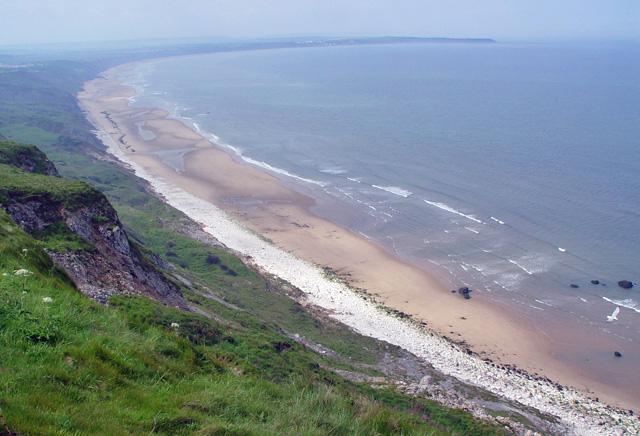
Just to the north of Filey, the bay ends at another headland. Known as Filey Brigg, this gives impressive views across Filey Bay, and along the North Yorkshire coastline as it stretches north-westwards towards Scarborough. Like much of the North Yorkshire coastline, this headland has some geological significance – the lower levels of the rock of this headland are Jurassic in age, and consist of limestone and gritstone, whereas the rock above contains clay and glacial till from the last Ice Age [2]. However, like much of the North Yorkshire coastline, erosion is a common occurrence on this headland, in part due to the softer clays and glacial till layers.
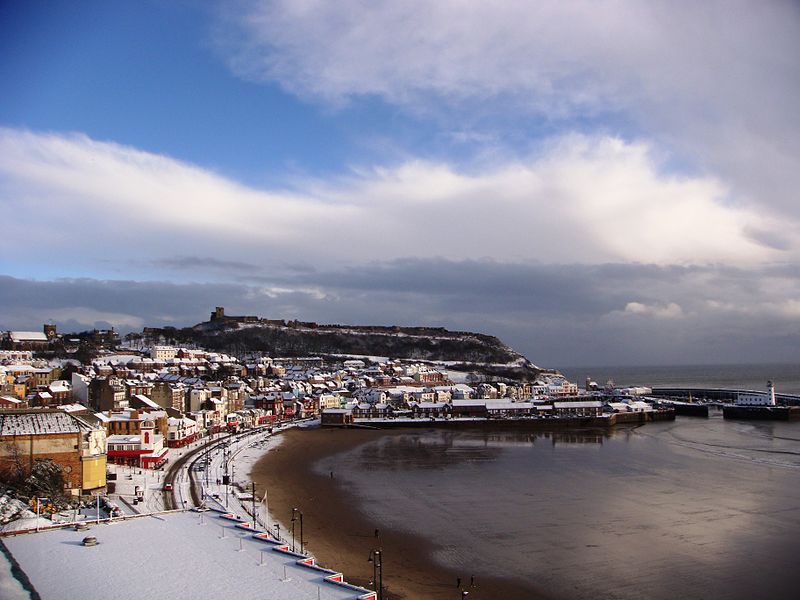
By Toubunshin, CC BY-SA 3.0 <https://creativecommons.org/licenses/by-sa/3.0>, via Wikimedia Commons
Heading north-westwards towards Scarborough Bay, the cliffs maintain their ruggedness. The resort town of Scarborough, which gives the bay its name, is one of the larger seaside towns on the North Yorkshire coast. A well-known historic tourist destination, Scarborough is characterised by distinctive Victorian-era buildings located on top of a low cliff.
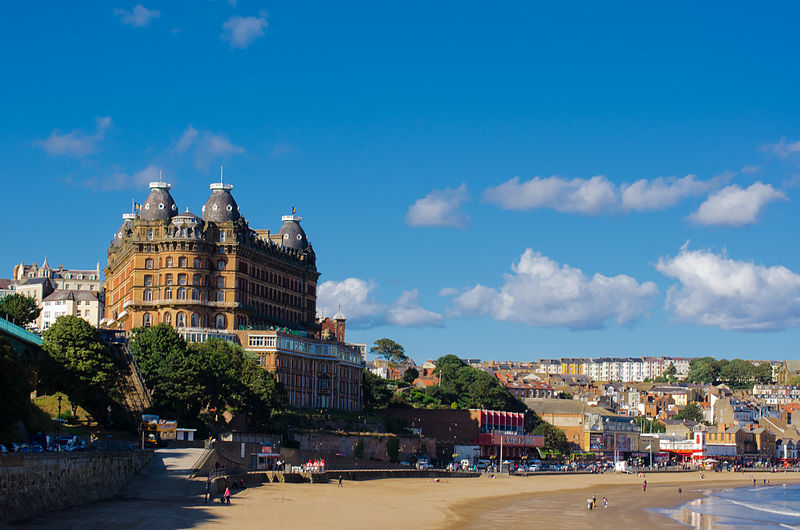
The Grand Hotel, Scarborough, North Yorkshire, England
By Thomas Tolkien – Flickr: Scarborough, North Yorkshire. (4 of 7), CC BY 2.0, https://commons.wikimedia.org/w/index.php?curid=22407162
This include the vast Grand Hotel, which with its distinctive yellow-brown appearance and Baroque-style architecture, dominates the view of the seaside town. Scarborough also has the usual amenities associated with a British seaside town: a Victorian promenade, an amusement arcade, many restaurants, independent shops, and a harbour which hosts a marina and offers pleasure cruises. This town is built around two bays – Scarborough Bay to the south and North Bay to the north – which are both separated by a headland, upon which sits a stone castle that dates back to the 1150s [3].
Moving northwards, the coastline enters the North York Moors National Park as it continues to wind around small coves and headlands. Here, the coast is more remote and the cliff height increases, giving this coastline a wilder feeling than the coast to the south of Scarborough.

At Ravenscar Headland, named after the village of the same name, amazing views can be seen across Robin Hood Bay to the north, along the cliffs to the south, and far out to sea. It is therefore no surprise that this vantage point was once used as a signal station by the Romans. As well as the village of Ravenscar, Raven Hall Hotel sits atop the 200m (600 feet) high cliffs here – this is a strikingly large Victorian building that adds to the grandeur of the landscape [4].
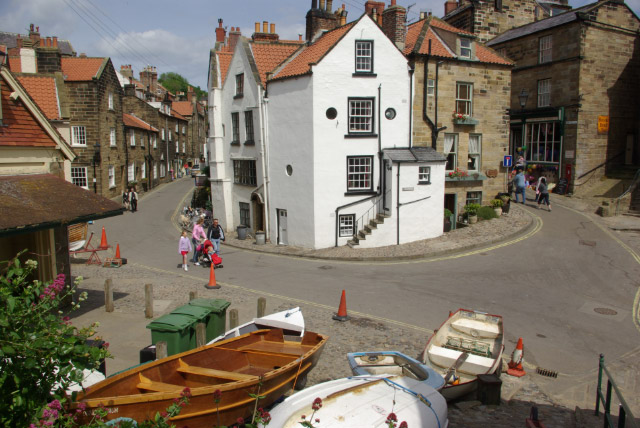
Around Robin Hood’s Bay, to the north of Ravenscar, although the cliffs lower considerably in height, they maintain their ruggedness whilst being bordered by pockets of coastal woodland. The historic village – also named Robin Hood’s Bay – consists of historic, tightly-packed cottages around narrow streets that spill down the hill to the shoreline. This picturesque village contains many small and quaint independent shops, as well as pubs, restaurants and hotels. 9km (5.5 miles) north-westwards along the coast sits another picturesque North Yorkshire town – Whitby.

Like at Robin Hood’s Bay, old and quaint buildings flow from the coastline (and the River Esk running through it) up onto the hills above. Whitby is world-famous for the ruins of Whitby Abbey, which provided a key inspiration for Bram Stoker’s novel Dracula, making this a very popular tourist destination [5].
Although parts of the Devon and Dorset coast in the south of England are renowned for their fossils, this coastline also contains a rather high proportion of preserved animal and plant remains from the Jurassic period. In particular (but not exclusively), the coast between Whitby and Staithes is a particular fossil hotspot. Ammonites, shells, reptile remains and a type of gemstone called jet – formed from the fossilisation of some wood types – can be found at numerous locations along this stretch of coastline [6]. Like with much of the North Yorkshire coastline, this segment is rather wild, and contains several bays and numerous headlands amongst the rugged coastline.

For example, the Kettle Ness headland stretches out into the North Sea, whereas the grand, sweeping Runswick Bay is located directly adjacent. There are also a few small seaside villages, including the small picturesque seaside village of Staithes, which is nestled tightly within a tight valley at the mouth of the Staithes Beck, a small stream that runs down from the North York Moors, and the North Sea [7].
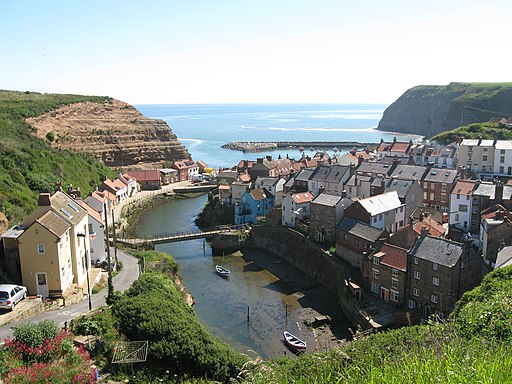
After more towering cliffs to the west of Staithes, we reach the northern boundary of the North York Moors National Park, and the cliffs begin to decrease in size and reduce their ruggedness. The seaside town of Saltburn-by-Sea marks the start of a rather sandy beach that runs north-westwards towards the River Tees, which marks the boundary between North Yorkshire and County Durham. However, before one reaches the River Tees, there is one last seaside town – Redcar.
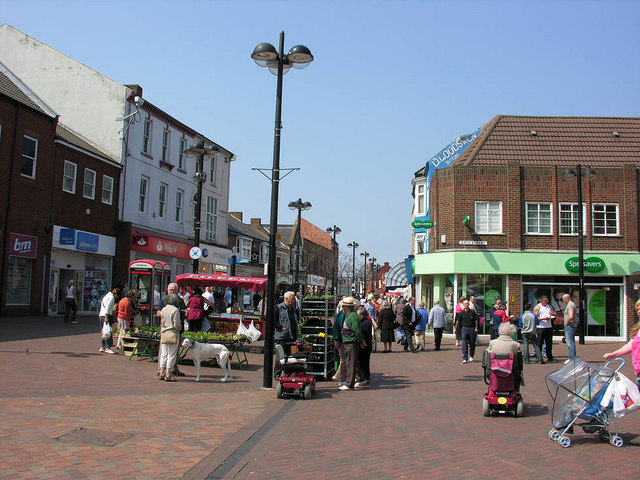
A traditional British seaside resort town, this contains an esplanade, amusement arcades and a nice sandy beach. Redcar Beacon also sits along the seafront – this 30m (80 foot) high observation tower was completed in 2013, and offers views all across Redcar [8].
The coastline continues for another 5km (3 miles) to the north-west of Redcar. The sandy beach is bordered by a sand dune system – it is behind these dunes where the derelict remains of Redcar Steelworks are located. The North Yorkshire coastline ends abruptly when it reaches the River Tees, which forms a small break in the coastline between the counties of North Yorkshire to the south and County Durham to the north.
References
[1] https://www.yorkshire.com/places/yorkshire-coast/filey
[3] https://www.yorkshire.com/places/yorkshire-coast/scarborough
[4] https://www.yorkshire.com/places/yorkshire-coast/ravenscar
[5] https://www.discoveryorkshirecoast.com/whitby
[6] https://ukfossils.co.uk/category/yorkshire/
[7] https://www.discoveryorkshirecoast.com/coastal-villages/staithes
[8] https://www.yorkshire.com/places/yorkshire-coast/redcar

